Massachusetts is the sixth smallest state of the United States, but it stands among the leaders in many fields. Only New Jersey, Hawaii, Connecticut, Delaware, and Rhode Island have smaller areas. Massachusetts ranks third among the most densely populated states, behind New Jersey and Rhode Island. Boston, the state’s capital and largest city, is a major U.S. air terminal and an important regional seaport. It is New England’s major center of finance and trade. Universities in and around Boston help make the area one of the world’s great cultural, educational, medical, and research centers. Historic landmarks make Massachusetts one of America’s main tourist spots.
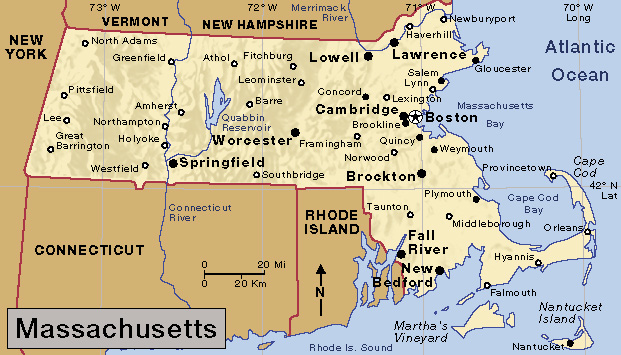
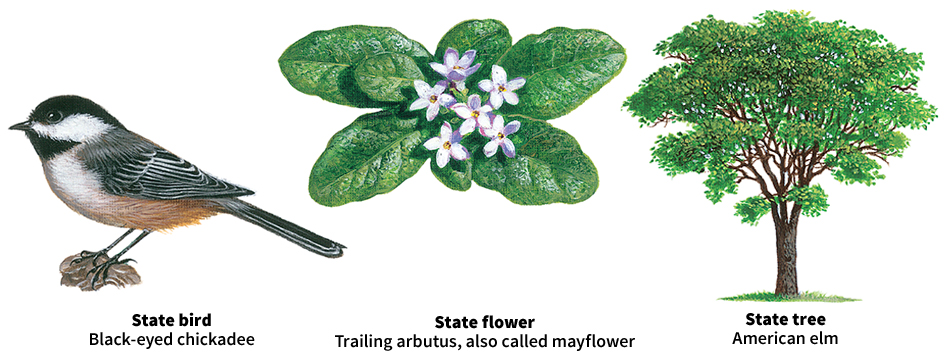

The land in Massachusetts is a series of hills and valleys. From sea level near the Atlantic Ocean, the state reaches a height of about 3,500 feet (1,100 meters) near its western border. The best farmland lies in the river valleys and near the coastline. Farmers near Cape Cod grow cranberries, a leading crop in the state. Boston, Gloucester, and New Bedford are major fishing ports.
The Norse explorer Leif Eriksson (also spelled Ericson, Ericsson, or Eiriksson) may have visited the Massachusetts region about the year 1000. He was one of the first Europeans to sail to North America. In 1620, the Pilgrims settled at what is now Plymouth. The Puritans came in 1630. Both these groups left England in search of better economic opportunities and freedom to pursue their religious beliefs. The first newspaper, printing press, and library in the British colonies were established in Massachusetts. The first college, Harvard, was founded at Cambridge in 1636. Boston Latin School, the first secondary school in the colonies, opened in 1635. The first public high school in the United States, Boston English High School, opened in 1821.
Many of the events that led up to the American Revolution took place in Massachusetts. These included the Boston Massacre in 1770 and the Boston Tea Party in 1773. On the night of April 18, 1775, Paul Revere made his famous ride to warn his fellow patriots that British troops were coming. On April 19, 1775, minutemen at Lexington and then at Concord fought the first battles of the American Revolution. On Feb. 6, 1788, Massachusetts ratified the U.S. Constitution, becoming the sixth state to join the Union.
Four U.S. presidents were born in Massachusetts. John Adams, the second president, and his son, John Quincy Adams, the sixth president, were both born in Braintree (now Quincy). John F. Kennedy, the 35th president, was born in Brookline. George H. W. Bush, the 41st president, was born in Milton. Calvin Coolidge, the 30th president, was born in Vermont but spent most of his adult life in Massachusetts. Coolidge held a number of political offices in the state, including governor.
Massachusetts gets its name from the Indigenous (native) Massachusett people, who lived in the region when the Pilgrims arrived. The name probably means near the great hill, or the place of the great hill. Historians believe it refers to the Great Blue Hill south of Boston. Massachusetts is often called the Bay State because the Puritans founded their colony on Massachusetts Bay. Massachusetts is one of four states officially called commonwealths. The others are Kentucky, Pennsylvania, and Virginia.
People
Population.
The 2020 United States census reported that Massachusetts had 7,029,917 people. The population had increased 7 percent over the 2010 figure of 6,547,629. According to the 2020 census, Massachusetts ranks 15th in population among the 50 states.
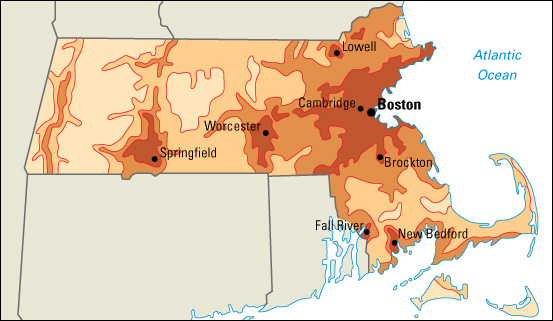
Almost all of the people of Massachusetts live within one of the metropolitan statistical areas that are entirely or partly in the state (see Metropolitan area). These areas are Amherst Town-Northampton, Barnstable Town, Boston-Cambridge-Newton, Pittsfield, Providence (Rhode Island)-Warwick (Rhode Island), Springfield, and Worcester.
Boston is the state’s largest city and the capital of Massachusetts. Other large cities in Massachusetts, in order of population, are Worcester, Springfield, Cambridge, Lowell, Brockton, and Quincy.
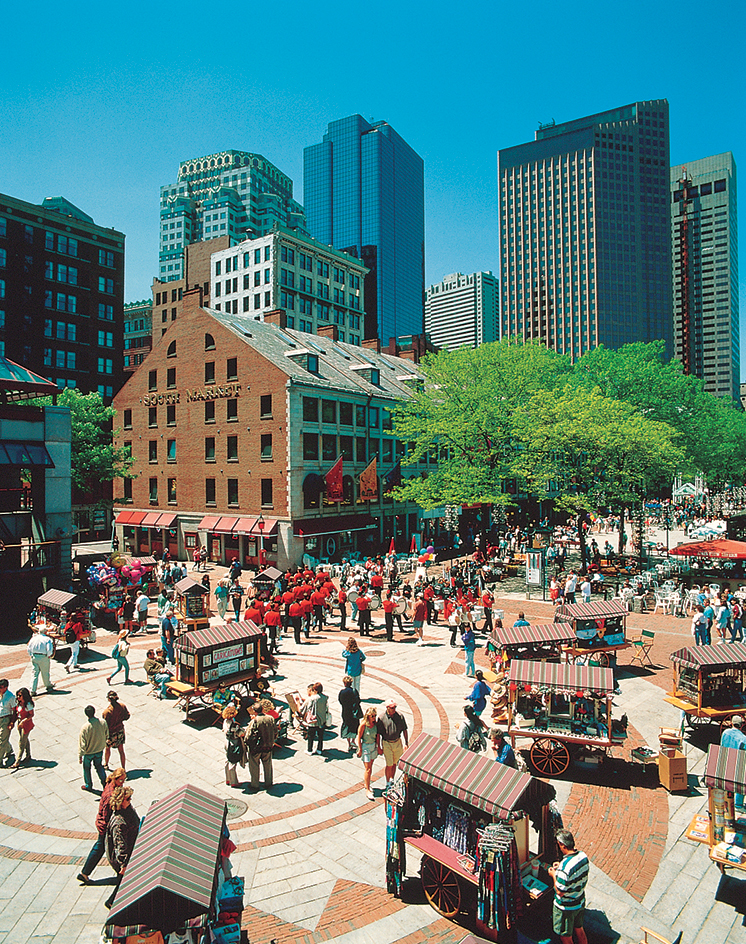
About 80 percent of the people living in Massachusetts were born in the United States. The largest groups of people born in other countries came from Canada, China, Portugal, and the Caribbean. The state’s largest population groups include people of English, French, Irish, and Italian descent. About 13 percent of the state’s people are Hispanic Americans. African Americans make up about 7 percent of the population, and Asian Americans also account for about 7 percent.
Schools.
The Puritans of Boston built the first school in Massachusetts in 1635. This school, the Boston Latin School, was the first secondary school in the American Colonies. In 1647, the Massachusetts Bay Colony ordered that elementary schools be established in all towns where there were 50 or more families. This action marked the first time that any government in the world provided free public education at public expense. In 1852, Massachusetts became the first state to require its children to attend school. 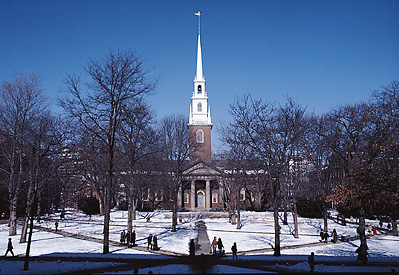
The state Department of Elementary and Secondary Education supervises public education from prekindergarten through secondary school, as well as vocational and adult basic education. The department has an 11-member Board of Elementary and Secondary Education. The board is made up of nine appointed members, a student representative, and the secretary of education. Children between the ages of 6 and 16 must attend school.
Massachusetts has some of the nation’s most highly regarded prep schools (private schools that prepare students for college). The state’s universities and colleges are highly acclaimed.
Libraries.
The first library in the American Colonies was established in Massachusetts in 1638, when John Harvard gave his collection of books to Harvard College. Harvard’s library is now the largest university library in the world. It has more than 20 million volumes.
Several Boston libraries own outstanding collections. These libraries include the Boston Athenaeum, which has George Washington’s collection of books; the John F. Kennedy Presidential Library; the Massachusetts Historical Society; the State Library of Massachusetts, in the State House; and the Boston Public Library.
Other Massachusetts libraries with important collections include the Phillips Library in Salem and the American Antiquarian Society in Worcester. The Harvard library owns collections of rare books and old South Asian manuscripts.
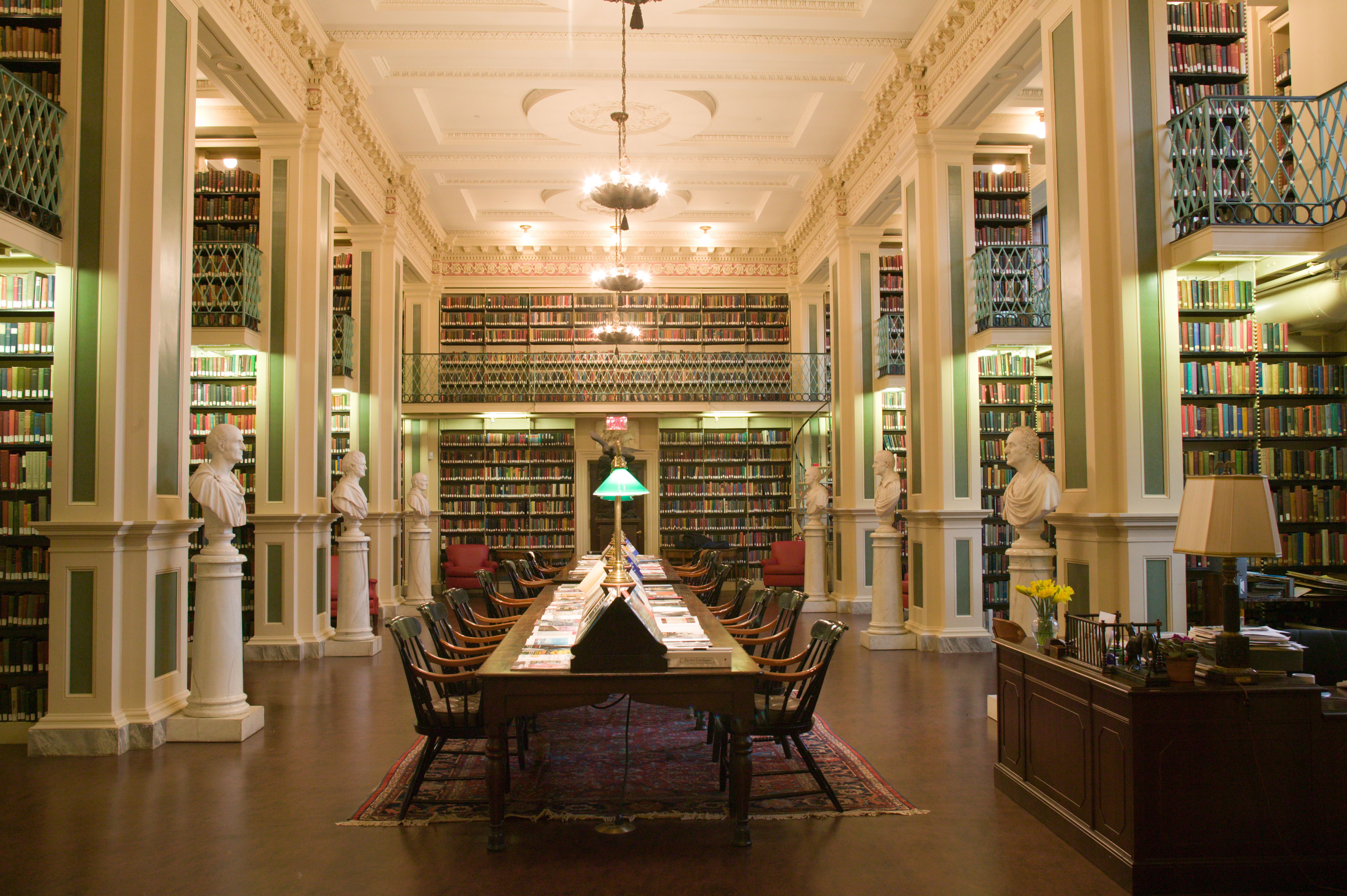
Museums.
The Museum of Fine Arts in Boston owns one of the nation’s largest collections of artwork. Also in Boston, the Isabella Stewart Gardner Museum, housed in a Venetian-style palace, has many outstanding Renaissance paintings. The Boston Children’s Museum is one of the oldest and largest in the nation. The George Walter Vincent Smith Art Museum in Springfield, the Worcester Art Museum, and the Sterling and Francine Clark Art Institute in Williamstown are among the nation’s best-known smaller museums. The Massachusetts Museum of Contemporary Art in North Adams displays many works too large to fit in traditional museums. Other museums include the Museum of Science in Boston, the New Bedford Whaling Museum, the Peabody Essex Museum in Salem, and the Norman Rockwell Museum at Stockbridge. The Salem Witch Museum uses a dramatic presentation of life-size figures and narration to give an overview of the 1692 Salem witchcraft trials.

Visitor’s guide
Skiing brings many visitors to the Berkshire Hills, Wachusett Mountain, and other parts of Massachusetts. The Atlantic Ocean and many lakes and rivers attract swimmers, fishing enthusiasts, and boaters. But Massachusetts offers perhaps its greatest rewards to the student of American history. Historic sites date back to the Pilgrims, to colonial witchcraft trials, and to the American Revolution.
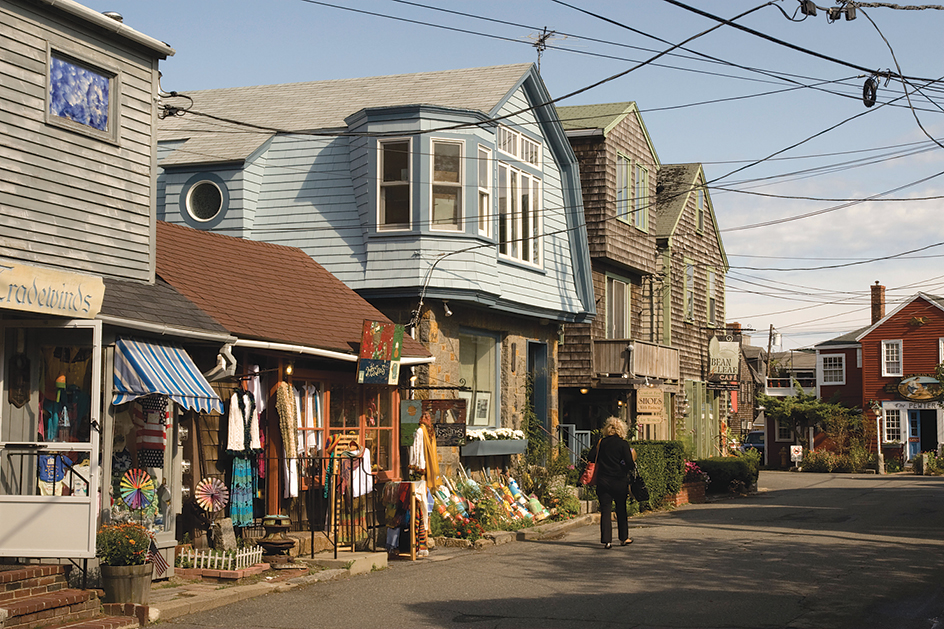
One of the outstanding yearly events in Massachusetts is the Tanglewood Music Festival, held in the Koussevitzky Music Shed near Lenox. This 210-acre (85-hectare) estate in the Berkshires is the summer home of the Boston Symphony Orchestra.
Land and climate
Land regions.
Massachusetts has six main land regions. They are, from east to west: (1) the Coastal Lowlands, (2) the Eastern New England Upland, (3) the Connecticut Valley Lowland, (4) the Western New England Upland, (5) the Berkshire Valley, and (6) the Taconic Mountains.
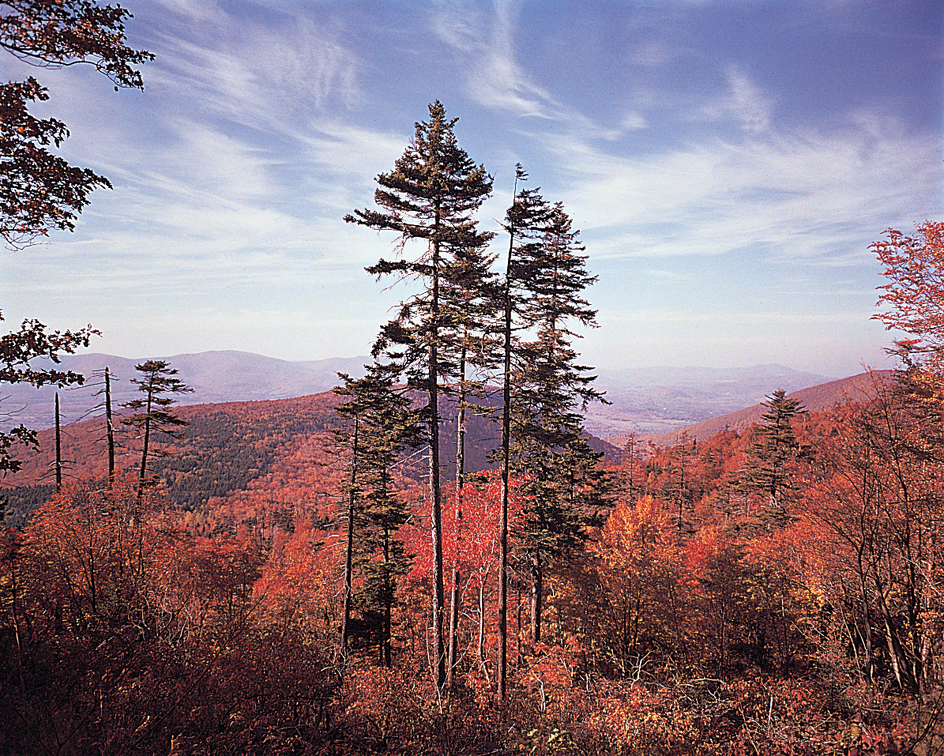
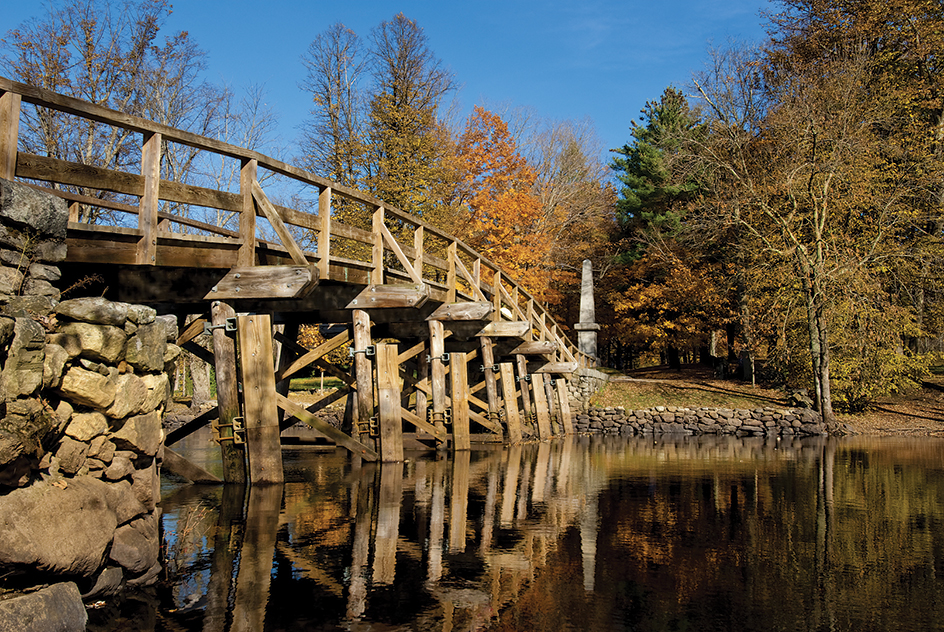
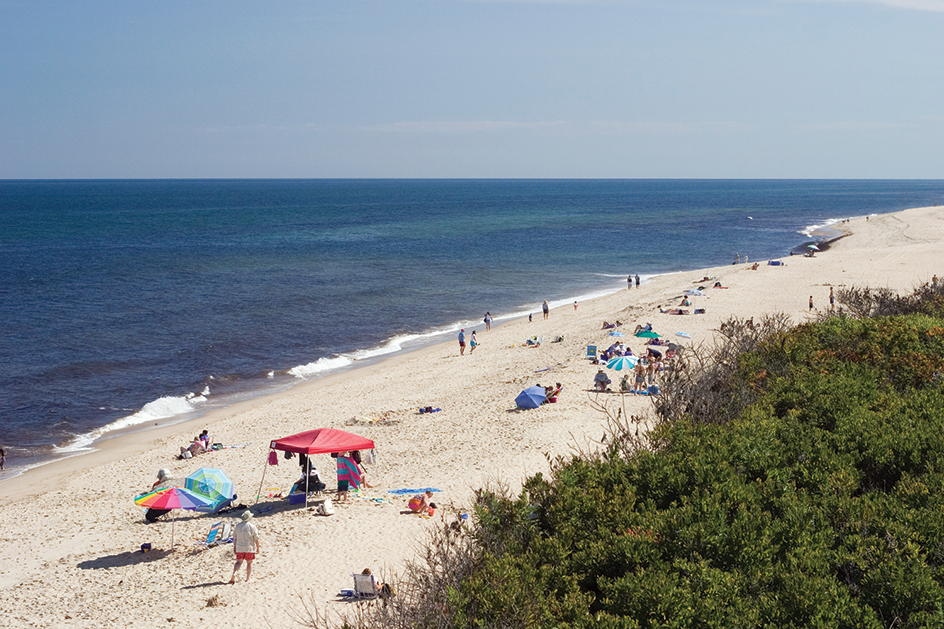
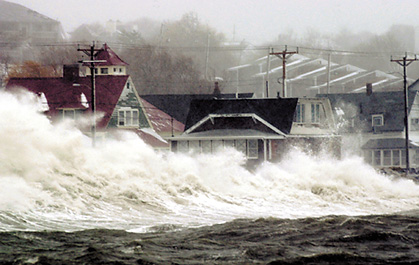
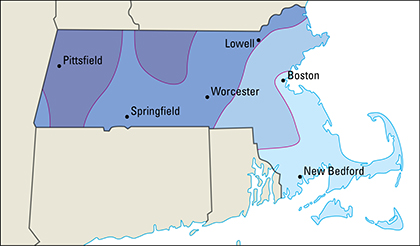
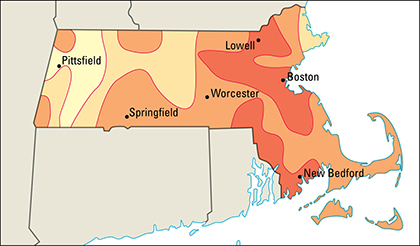
The Coastal Lowlands
are part of a large land region that extends over the entire New England coastline. The lowlands make up the eastern third of Massachusetts. They also include Nantucket Island, Martha’s Vineyard, the Elizabeth Islands, and other smaller offshore islands. The region has many rounded hills, swamps, small lakes and ponds, and short shallow rivers. The lowlands are dotted with glacial deposits. These deposits were left by glaciers during the Pleistocene Epoch, a time marked by a succession of ice ages, which ended about 11,500 years ago. The Great Blue Hill, south of Boston, rises to a height of about 635 feet (194 meters). Several excellent harbors lie along the coast. They include Boston, Gloucester, and New Bedford.
The Eastern New England Upland
makes up part of a land region that stretches from Maine to New Jersey. The upland is an extension of the White Mountains of New Hampshire. In Massachusetts the upland extends westward from the Coastal Lowlands for 40 to 60 miles (64 to 97 kilometers). The upland region rises to a height of about 1,000 feet (300 meters) and then gradually slopes downward toward the Connecticut Valley Lowland. In this region, Wachusett Mountain, at 2,006 feet (611 meters), towers over its surrounding area. Many streams cut through the Eastern New England Upland.
The Connecticut Valley Lowland
is a long, sausage-shaped region. It extends from northern Massachusetts to southern Connecticut. In Massachusetts, the valley, which is 20 miles (32 kilometers) wide, is hemmed in by hills to the north, east, and west. The Connecticut River flows through the valley region. Rich soil and a mild climate provide good farming.
The Western New England Upland
extends through Vermont, Massachusetts, and Connecticut. In Massachusetts, the region stretches 20 to 30 miles (32 to 48 kilometers) westward from the Connecticut Valley Lowland to the Berkshire Valley. The Berkshire Hills, a range that covers this region, is an extension of the Green Mountains of Vermont. In Massachusetts, the Western New England Upland region itself is often called the Berkshire Hills. The land rises from the Connecticut Valley to rugged, beautiful heights of more than 2,000 feet (610 meters). In this region is majestic Mount Greylock, which rises 3,491 feet (1,064 meters) and is the highest point in Massachusetts. Farms and towns lie on the region’s slopes.
The Berkshire Valley
is a narrow path of lower land that extends into northern Connecticut. In Massachusetts, it winds between the Berkshire Hills and the Taconic Mountains. This valley region is less than 10 miles (16 kilometers) wide. Its many green meadows are good for dairy farming.
The Taconic Mountains
extend into Vermont. This region skirts the extreme western edge of Massachusetts. At its widest point, the region measures no more than 6 miles (10 kilometers) across. The Taconic Range slopes from northwestern Massachusetts to the southwestern corner of the state, where Mount Everett rises 2,602 feet (793 meters).
Coastline
of Massachusetts measures 192 miles (309 kilometers). If the coastline of each bay and inlet were added to the total, the state’s coastline would measure more than 1,500 miles (2,410 kilometers). Boston is the state’s most important harbor. Other important harbors include Gloucester in the north, Quincy and Weymouth in Boston Bay, and New Bedford and Fall River in the south.
Islands.
The Elizabeth Islands, Martha’s Vineyard, and Nantucket Island are the state’s largest and most important islands. Together with Cape Cod, these islands form the boundaries of Nantucket Sound. Martha’s Vineyard and Nantucket Island are important resort centers. A number of smaller islands also lie along the coast of Massachusetts.
Rivers and lakes.
Massachusetts has 4,230 miles (6,808 kilometers) of rivers. The Connecticut River is the state’s most important waterway. It flows southward and provides water for the most fertile Massachusetts farmlands. The Connecticut’s chief tributaries include the Deerfield and Westfield rivers to the west and the Chicopee and Millers rivers to the east.
The far western part of Massachusetts has two important rivers—the Hoosic River and the Housatonic River. The Hoosic River flows northward and westward into Vermont and finally drains into the Hudson River. The scenic Housatonic River flows southward into Connecticut. The Blackstone River drains Massachusetts’s eastern upland region. It then flows southeastward into Rhode Island.
The Merrimack River is the most important river in the Coastal Lowlands. It enters the state from New Hampshire. Then the Merrimack turns abruptly northeastward and flows almost parallel to the Massachusetts border until it empties into the Atlantic Ocean at Newburyport. The Nashua and Concord rivers are the Merrimack’s main tributaries. The Charles, Mystic, and Neponset rivers all empty into Boston Harbor. The Taunton River flows southward into Rhode Island’s Mount Hope Bay.
Massachusetts has more than 1,300 lakes and ponds. More than a fourth of these lakes supply drinking water to nearby cities and towns. The state’s two largest lakes—Quabbin and Wachusett—are artificially created reservoirs. Quabbin Reservoir, near Ware in the center of the state, is one of the nation’s largest reservoirs of drinking water. It covers more than 39 square miles (101 square kilometers). Wachusett Reservoir, north of Worcester, covers 61/2 square miles (17 square kilometers). These reservoirs supply water to the Boston metropolitan area.
Many of the state’s lakes have Indigenous names. For example, Lake Chaubunagungamaug, also called Lake Webster, received its name from the Nipmuc people. The long form for this name is Chargoggagoggmanchauggagoggchaubunagungamaug. The name means “You fish your side of the lake. I fish my side. Nobody fishes the middle.”
Plant and animal life.
Forests cover about three-fifths of the state’s land area. The most common softwood trees include the eastern white and red pines, the eastern hemlock, and the pitch pine. Common hardwoods include ash, beech, birch, maple, and oak trees.
Every spring, blue and white violets blossom along the river valleys and in the lower portions of the upland regions. Marsh marigolds, skunk cabbages, and white hellebores also cover these regions in the springtime. Common shrubs and plants in the western hilly regions include azaleas, dogwoods, ferns, mountain laurels, rhododendrons, and viburnums. Mayflowers, Solomon’s-seals, and trilliums are also common in the western regions. Rushes and sedges thrive along the seacoast and in the Coastal Lowlands.
Massachusetts’s forests and woodlands are filled with foxes, muskrats, porcupines, rabbits, raccoons, and skunks. The tiny meadow mouse is the state’s most common animal. Deer and moose live throughout the state. Great numbers of beavers live in the streams of the Berkshire Hills. Partridge, pheasant, and other game birds are found in the fields and forests. Many kinds of water, marsh, and shore birds, especially gulls and terns, nest along the seacoast.
Bass, pickerel, sunfish, trout, and white and yellow perch swim in the state’s lakes and ponds. Clams, fishes, lobsters, and oysters are found in the coastal waters. Massachusetts has many kinds of snakes. Poisonous copperheads and timber rattlesnakes live in the Berkshire and Blue hills.
Climate.
Western Massachusetts is colder than the eastern part of the state. Boston, on the eastern edge of the state, has an average July temperature of 73 °F (23 °C) and an average January temperature of 29 °F (—2 °C). In the west, Pittsfield averages 69 °F (21 °C) in July and 21 °F (—6 °C) in January. Worcester, in the central portion of the state, has a July average of 70 °F (21 °C) and a January average of 24 °F (—4 °C). 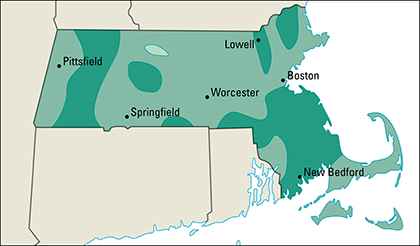
The highest temperature ever recorded in the state was 107 °F (42 °C) at New Bedford and Chester on Aug. 2, 1975. The lowest recorded temperature, —35 °F (—37 °C), occurred at Taunton on Jan. 5, 1904; at Coldbrook on Feb. 15, 1943; and at Chester on Jan. 12, 1981.
The state’s precipitation averages about 46 inches (117 centimeters) a year. From 55 to 75 inches (140 to 191 centimeters) of snow falls in the western mountains of Massachusetts each year. The central part of the state averages about 49 inches (124 centimeters) a year and the coastal area about 42 inches (107 centimeters). Hurricanes occasionally lash the Massachusetts coastline. Especially destructive hurricanes hit the state in 1938, 1944, and 1985.
Economy
Service industries, taken together, account for the largest portion of Massachusetts’s gross domestic product—the total value of all goods and services produced in the state in a year. The manufacture of computers and electronic products is also a major part of the Massachusetts economy.
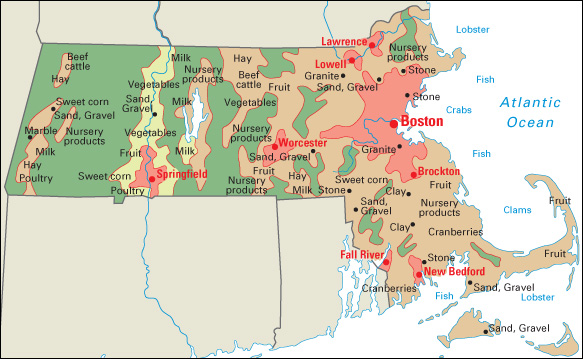
Each year, tens of millions of tourists visit Massachusetts. They contribute billions of dollars to the state’s economy, primarily to the service industries. Tourism thrives around the Boston area, on Cape Cod and neighboring islands, and in the Berkshires.
Natural resources
include fertile river valley soils and deposits of sand and gravel and other building materials.
Soil.
Most of the river valleys have deep soils that are rich in peat. The Connecticut River Valley has the most fertile soil in the state. The marshy soils of the Coastal Lowlands, with underground peat deposits, are also rich. But much of the state’s soil contains sand and gravel. Stones and boulders, deposited long ago by melting glaciers, are also common. These gravel and sandy acid soils are not fertile. Farmers must treat them with large amounts of fertilizer.
Minerals.
Building materials are the primary mined products of Massachusetts. Sand and gravel deposits lie mostly in eastern Massachusetts. Deposits of dolomitic marbles are found in Ashley Falls, Lee, and West Stockbridge.
Service industries
account for the largest part of both the employment and the gross domestic product of Massachusetts. These industries operate chiefly in the Boston area.
Boston ranks among the nation’s major financial centers. Fidelity Investments, a major mutual fund firm, is headquartered in the city. In addition, Boston is the home of a stock exchange and many large insurance firms and holding companies. Large financial companies are also based in Springfield and Worcester.
State government activities are based in Boston. The city is one of the world’s leading centers of medical research. Private universities and colleges are major employers in Massachusetts. The state’s hotels, restaurants, and retail trade establishments are primarily in the Boston area. They benefit especially from the tens of millions of tourists who visit the state each year.
Manufacturing.
Computer and electronic products are the state’s leading manufactured products. Computer equipment, including microchips, are a major part of this industry. Electronics companies Hewlett-Packard and Intel have manufacturing and research operations in the state. The Boston area has many factories that make computers. Also important is communications equipment, especially broadcasting devices and telephone equipment, and search and navigation equipment. 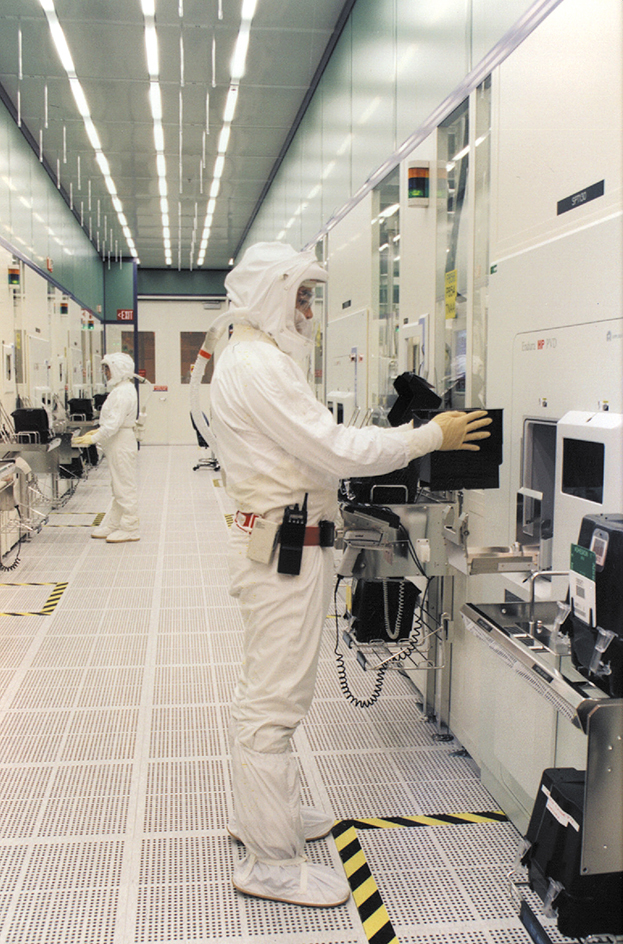
The state also produces chemicals, fabricated metal products, food and beverages, machinery, and medical equipment. All of these are primarily manufactured in the Boston area. Pharmaceuticals (medicinal drugs) are the state’s leading chemical product. Fabricated metal products include ammunition, guns, hand tools, and machine shop products. Bakery goods, dairy products, fish, and meat are the leading food and beverage products. Types of machinery include metalworking machinery and machines for the computer industry. Massachusetts is a leading state in the manufacture of medical equipment.
Agriculture.
Farmland covers about 10 percent of the land area of Massachusetts. Greenhouse and nursery products are the state’s leading source of farm income.
Cranberries rank second in value among farm products in Massachusetts. The state produces about a fourth of the cranberries grown in the United States. Most of the cranberries are grown in bogs in marshy areas of the coastal lowlands west of Cape Cod.
Milk is the leading livestock product of Massachusetts. Massachusetts farmers also produce apples, beef cattle, hay, peaches, potatoes, sweet corn, and turkeys.
Mining.
The production of crushed stone and of sand and gravel provides most of the state’s mining income. Granite, limestone, and traprock are the leading crushed stone products. Eastern Massachusetts leads in sand and gravel production. Clay and lime are also mined in the state.
Fishing industry.
Massachusetts ranks among the leading commercial fishing states. Gloucester and New Bedford rank among the leading United States ports in annual fish catch. Scallops are Massachusetts’s leading fishing catch, and lobsters are second. Massachusetts ranks as a leading state in the production of both scallops and lobsters. Massachusetts is also a leading state producer of clams, cod, flounders, goosefish, hake, herring, oysters, pollock, and tuna.
Electric power and utilities.
Natural gas burning plants provide over half of the electric power in Massachusetts. An increasing amount of the state’s power comes from solar, water, wind, and other renewable sources.
Transportation.
Logan International Airport in Boston is the state’s busiest airport. Rail lines provide freight service in the state. Passenger trains serve several cities. Boston has a large mass transit system.
Massachusetts has an extensive system of roads and highways. The Massachusetts Turnpike, a toll road, stretches between Boston and the New York state line. Two major highways swing in an arc around Boston—Route 128 and, farther west, Route 495.
Boston is the main seaport for Massachusetts and for much of New England. Boston’s port handles mainly containerized goods, which are shipped in prepackaged units called containers, and petroleum products. Fall River is the second largest port in Massachusetts.
Communication.
In 1639, Stephen Daye established the first printing press in the English colonies in Cambridge. Daye started his press only 19 years after the Pilgrims landed in Massachusetts. In 1640, he printed the Bay Psalm Book, the first English-language book published in America.
The first two newspapers in the colonies were published in Boston. Publick Occurrences Both Forreign and Domestick was established in 1690. The Boston News-Letter was the first successful newspaper in America.
Today, daily newspapers with the largest circulations include The Boston Globe, the Boston Herald, the Cape Cod Times in Hyannis, The Eagle-Tribune in Lawrence, The Patriot Ledger in Quincy, The Republican in Springfield, The Sun in Lowell, and the Telegram & Gazette in Worcester.
Government
Constitution.
Massachusetts adopted its Constitution in 1780, during the American Revolution. Its Constitution is the oldest state constitution still in use, though it has been amended (changed) more than 100 times.
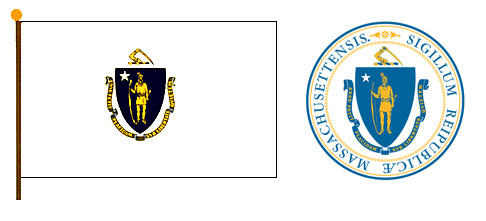
The Constitution provides for two kinds of amendments. Legislative amendments, the more common type, are introduced by members of the legislature. Initiative amendments are introduced to the legislature on petitions signed by a specified number of voters. Both types of amendments must be approved during joint sessions of the legislature. Legislative amendments require approval by a majority of the legislature. Initiative amendments must be approved by one-fourth of the legislators. All amendments must then be approved in a similar manner by the next legislative body. Finally, an amendment must be approved by a majority of the people voting on it in a general election. An initiative amendment must also receive approving votes equal to 30 percent of the number of ballots cast in the election.
A third procedure for a constitutional amendment, set by precedent in 1779, allows for the calling and holding of a constitutional convention. Before a constitutional convention can meet, it must be approved by a majority of the legislators and two-thirds of the state’s voters.
Executive.
The governor and lieutenant governor of Massachusetts are elected to four-year terms. The voters also elect the secretary of the commonwealth, the treasurer and receiver general, the attorney general, and the state auditor to four-year terms.
The governor is assisted by a cabinet, made up of the appointed heads of the state’s executive departments. The governor appoints the heads of state departments and the members of state agencies and nominates judges. The governor’s judicial nominations are subject to approval by the Governor’s Council, also known as the Executive Council. The Governor’s Council consists of the lieutenant governor and one member elected from each of eight state districts.
Legislature,
called the General Court, consists of a 40-member Senate and a 160-member House of Representatives. Each of the state’s 40 senatorial districts elects one senator, and each of the representative districts elects one representative. All members of the legislature serve two-year terms. 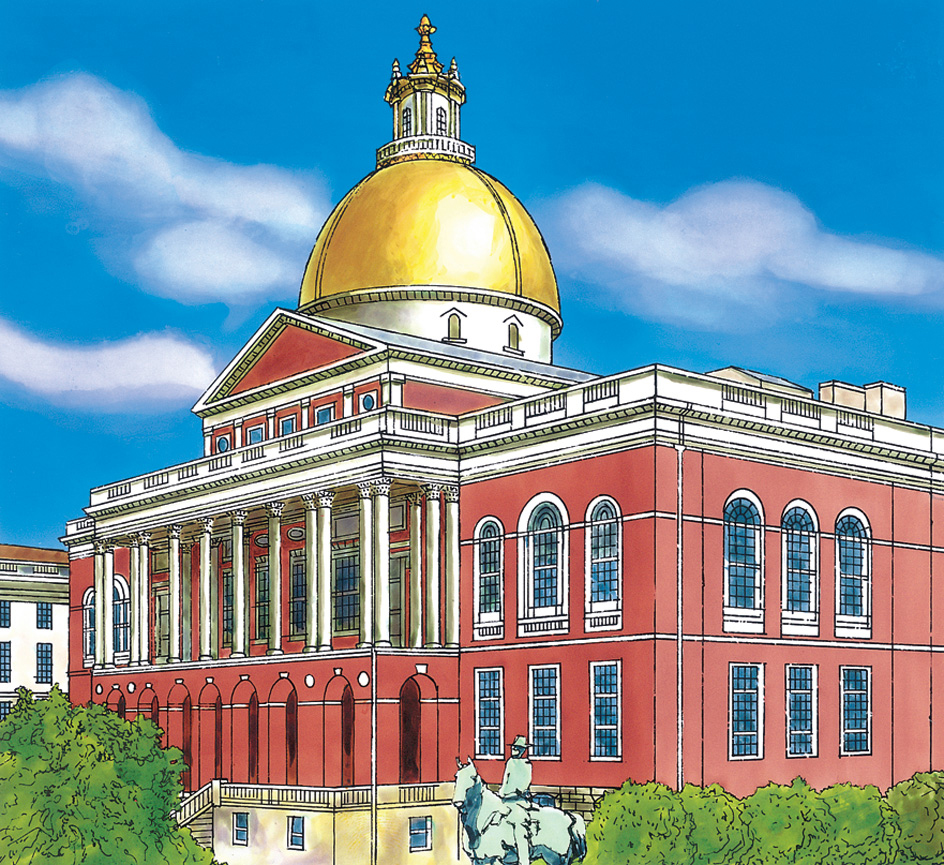
Both houses meet every year beginning on the first Wednesday in January. The session is scheduled to end on the Tuesday that precedes the first Wednesday in January of the second year of session. But it may end earlier if the legislature and the governor agree that all business is completed.
Courts.
All judges in Massachusetts are appointed by the governor and may serve until the age of 70. The Supreme Judicial Court is the state’s highest court. It has a chief justice and six associate justices. The Appeals Court handles appeals of civil and criminal cases. It consists of a chief justice and 24 associate justices. The Superior Court is the main trial court in the state. This court has a chief justice and 81 associate justices. Other state courts include district, housing, juvenile, land, Boston Municipal, and probate and family courts.
Local government
in Massachusetts is centered in dozens of chartered cities and in hundreds of incorporated towns. Most of the cities have a mayor-council government. Some use a council-manager system. A town in Massachusetts is similar to a township in other states. Like a township, a town may consist of several villages and rural areas. The entire town is governed as a single unit.
Towns in Massachusetts are governed by annual town meetings. Many small towns hold open meetings at which any voter in the town can participate. Most large towns hold representative meetings at which only elected members are allowed to vote. Voters express their opinions about town issues and make plans for the coming year. They also choose officials called selectmen to carry out the town’s business until the next meeting. Massachusetts cities and towns have home rule (self-government). Under the state’s home rule, communities may pass some laws dealing with local matters without interference from the state government.
Counties serve mainly as judicial boundaries. The state’s 14 counties are divided into districts. Each county has one or more district courts. Each county elects a register of deeds, a register of probate and insolvency, a district attorney, a sheriff, and clerks of court. Since 1997, the governments of about half of the Massachusetts counties have been abolished, and many of their functions have been absorbed by the state government. Voters in these counties do not elect a register of deeds. The remaining counties, except for Nantucket and Suffolk, elect commissioners and treasurers.
Revenue.
Taxes provide about half of Massachusetts’s general revenue (income). Much of the rest comes from federal grants and programs. Important sources of tax revenue include a personal income tax, a general sales tax, and taxes on corporate income and motor fuels.
Politics.
Except for the office of governor, the Democratic Party has dominated state government in Massachusetts. Democrats have won the state’s electoral votes in most presidential elections since the late 1920’s. For the state’s voting record in presidential elections, see Electoral College.
History
Early days.
Archaeological evidence shows that human beings arrived in the Massachusetts area more than 10,000 years ago. Early European explorers saw Indigenous Algonquian peoples in the region about 1500. The Algonquian tribes included the Massachusett, Nauset, Nipmuc, Pennacook, Pocomtuc, and Wampanoag. Diseases introduced by the Europeans killed many of these people in 1616 and 1617. By the time European colonists arrived in 1620, the Indigenous population had dropped from about 30,000 to about 7,000.
Early exploration.
The first Europeans to reach Massachusetts were possibly Vikings in about the year 1000. Some French and Spanish fishermen may have visited the region during the 1400’s.
In 1602, Bartholomew Gosnold of England landed on Cuttyhunk Island in the Elizabeth Islands. He gave Cape Cod its name. In 1605 and 1606, Samuel de Champlain of France drew maps of the New England shoreline. John Smith, an English sea captain, sailed along the coast of Massachusetts in 1614. Smith’s book A Description of New England (1616) guided settlers to the coast.
The Pilgrims and Plymouth Colony.
In the 1500’s, some members of the Church of England, known as Puritans, favored reforms to “purify” the church. By the late 1500’s, some Puritan congregations had broken away from the church entirely, and had become known as Separatists. Some Separatists sought religious freedom in Holland, then decided to begin a new life in America. 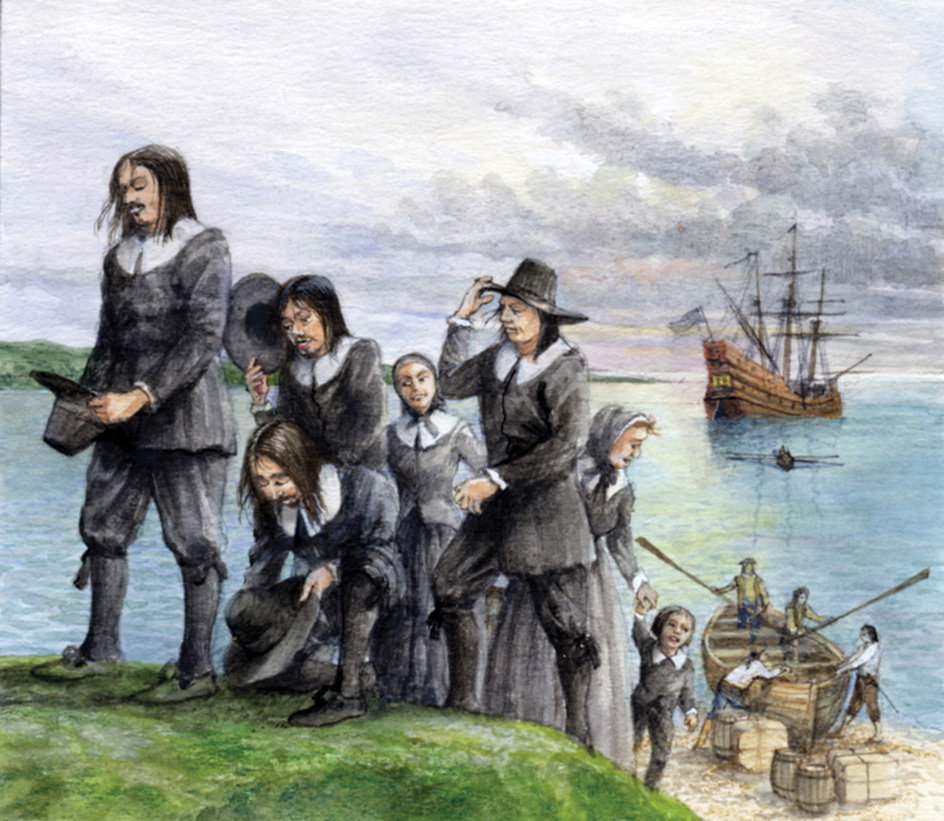

The early English settlers of New England became known as the Pilgrims. On Sept. 16, 1620, 41 Separatists and 61 other people from England became the first group of Pilgrims to journey to America. These Pilgrims sailed from Plymouth, England, in the Mayflower. That November, the Mayflower anchored in what is now Provincetown harbor. Before leaving the ship, the Pilgrims drew up a plan of self-government, which they called the Mayflower Compact. In December, they sailed across Cape Cod Bay and settled in Plymouth.
The Pilgrims suffered great hardships during their first winter in America. They had little food other than the game they could hunt. Their houses were crude bark shelters. About half the settlers died during the winter of 1620-1621. Early in 1621, the Pilgrims became friendly with some Indigenous Wampanoag people. The Wampanoag taught them how to plant corn and beans. By the time cold weather came again, the settlers were living more comfortably. They had enough food to last the winter. The Pilgrims celebrated the first New England Thanksgiving in 1621.
More settlers came to the Plymouth Colony during the years that followed. Within 20 years after the Pilgrims landed, Plymouth Colony had eight towns and about 2,500 people.
Massachusetts Bay Colony.
In 1628, a joint-stock company composed of English Puritans sent a group of settlers to the Massachusetts Bay area. They joined a small settlement already there, later named Salem. In 1629, King Charles I of England granted a charter to the company. The charter gave the company a stronger right to settle and govern the area. In 1630, the English lawyer John Winthrop led about 1,000 Puritans to Salem. Later that year, they left Salem and founded a settlement in the area of present-day Boston. The colony prospered and grew. By 1640, the Massachusetts Bay Colony had about 10,000 settlers. 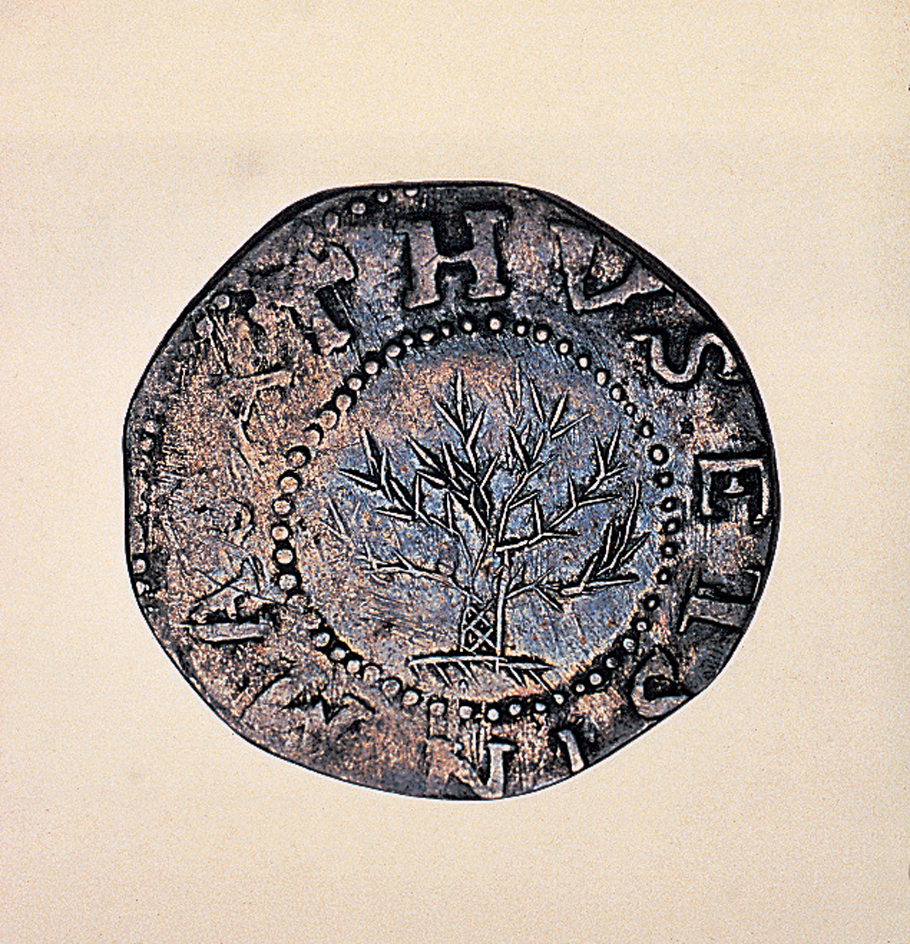
Other colonies.
The Massachusetts Bay Colony established political freedom and a representative form of government. In 1641, the first code of laws of the colony was set down in a document known as the Body of Liberties. But the Puritans permitted no religion except their own in the colony. Some religious groups were put out of the colony, and others left on their own. These Massachusetts settlers helped colonize other parts of New England in their search for religious freedom. They established settlements in Connecticut in 1635, Rhode Island in 1636, New Hampshire in 1638, and Maine in 1652. Connecticut and Rhode Island soon became independent colonies. New Hampshire did not separate from Massachusetts until 1680. Maine remained a part of Massachusetts until 1820.
King Philip’s War.
Massasoit, the sachem (leader) of the Wampanoag tribe, had been a friend of the Plymouth colonists. But his son Metacom, also called King Philip, became sachem in 1662. Metacom feared the white settlers. He believed that they would wipe out the Wampanoag and seize their lands.
In 1675, fighting began between the Wampanoag, led by Metacom, and the colonists of Plymouth and Massachusetts Bay. The struggle became known as King Philip’s War. White and Wampanoag settlements were burned and hundreds of men, women, and children died on both sides. An Indigenous man serving with colonial troops killed Metacom in 1676, ending the war in southern New England. Fighting continued in northern New England until 1678. The conflicts in eastern, central, and southern Massachusetts ended.
Troubles with England.
Although Massachusetts belonged to England, the colonists often resisted controls from across the sea. England believed that its colonists should trade only with the mother country. But many Massachusetts colonists disagreed, and they traded with other countries. Attempts at stricter control had little effect on some of the colonists. In 1684, King Charles II canceled the Massachusetts charter.
James II became king of England in 1685. In 1686, he established a government in Massachusetts and other northern colonies called the Dominion of New England. The king made Sir Edmund Andros governor of the dominion.
King James was overthrown in 1688. His daughter, Mary, and her husband, Prince William of Orange, became joint rulers of England in 1689. When the Massachusetts colonists received the news, they put Andros out of office and set up a temporary government of their own. William and Mary granted a new charter to Massachusetts in 1691. This charter combined the Plymouth Colony with the Massachusetts Bay Colony and added the island of Martha’s Vineyard.
In 1692, Sir William Phips became the first royal governor of Massachusetts. One of his most important acts was to end the persecution of people believed to be witches (see Witchcraft).
The French and Indian wars.
In 1689, the first of the four French and Indian wars broke out. The English colonists fought the French colonists and France’s Indigenous allies. At the time, the Europeans called the Indigenous people Indians. From 1689 to 1713, settlers along Massachusetts’s northern and western borders fought off continuous attacks by French soldiers and Indigenous warriors. In 1713, the United Kingdom, France, and other European nations signed a peace treaty at Utrecht, the Netherlands. An era of prosperity began in Massachusetts. Dozens of towns sprang up in the central and western areas of the colony. But the wars broke out again in the 1740’s. They finally ended in 1763 with victory for the British.
Pre-Revolutionary days.
The colonial wars left the United Kingdom in debt. To help pay for defense of the colonies, the British placed severe taxes on the American colonies. The Massachusetts colonists ignored most of these taxes. But the Stamp Act of 1765 led to bitter protests (see Stamp Act). The cry of “no taxation without representation” spread through the colony. An angry mob destroyed the lieutenant governor’s home. The presence of British soldiers in Boston added to the bitterness between the colonists and the Crown. In 1770, British soldiers killed several colonists while fighting a Boston mob. This incident became known as the Boston Massacre. In 1773, angry colonists staged the Boston Tea Party to protest a British tea tax. The colonists dumped 342 chests of British tea into Boston Harbor. 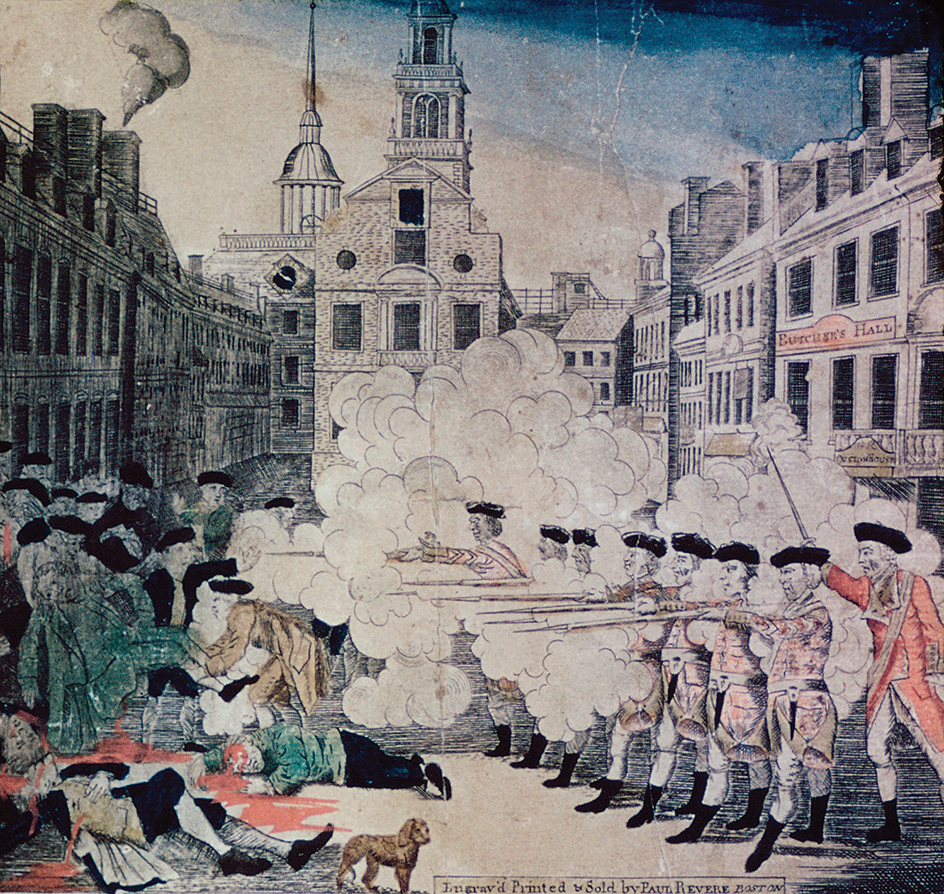
The British passed a series of measures to punish the colonists. But these measures merely angered the colonists more and helped bring all the American colonies together. On April 18, 1775, British troops marched from Boston to seize or destroy supplies of gunpowder hidden by the colonists at Concord. Paul Revere and others rode across the Massachusetts countryside to warn their fellow patriots that the British were coming. The next morning, American minutemen at Lexington fought the opening battle of the American Revolution (see Minutemen). 
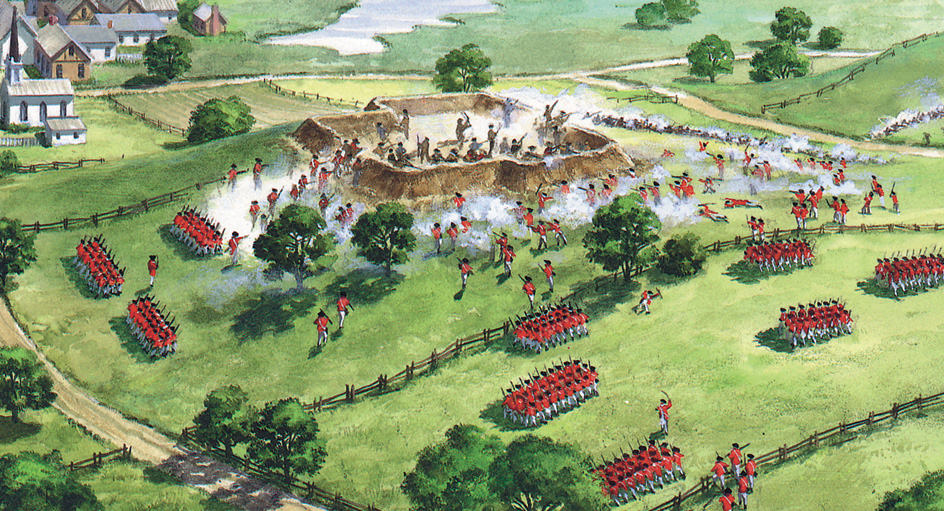
The American Revolution
began in Massachusetts. Much of the early fighting took place on Massachusetts soil. Massachusetts soldiers fought bravely at Lexington, Concord, and at Bunker Hill. On July 3, 1775, General George Washington took command of the Continental Army in Cambridge. In the spring of 1776, Washington drove the British out of Boston in the first major American victory of the war. Much of the fighting moved out of Massachusetts and into New York, New Jersey, and Pennsylvania in 1776. But Massachusetts continued to send soldiers and supplies to the American forces. At sea, Massachusetts ships inflicted heavy damage on British merchant ships.
The effects of the American Revolution in Massachusetts were felt most by the farmers. Prices of farm products dropped after the war ended in 1783. Money became so scarce that many farmers could not pay their taxes or debts. The farmers, facing the danger of losing their farms and going to prison, grew restless. In September 1786, Daniel Shays led a group of angry farmers to protest in front of the courthouse in Springfield. Fighting broke out between the farmers and government troops. The fighting, which became known as Shays’s Rebellion, ended when the farmers surrendered in February 1787. 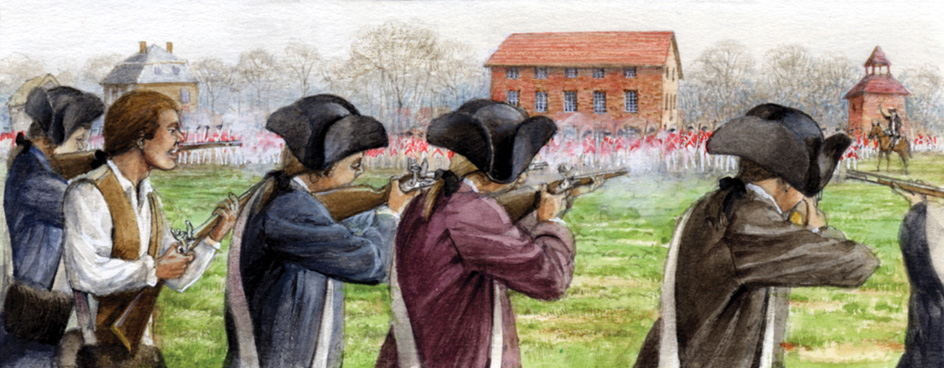
Massachusetts farmers also opposed ratification (approval) of the United States Constitution. They felt that the Constitution was more favorable to trade and finance than to agriculture. On Feb. 6, 1788, Massachusetts ratified the Constitution and became the sixth state in the Union. Massachusetts ratified the Constitution only on the condition that certain amendments concerning individual rights be added. The Bill of Rights to the U.S. Constitution went into effect on Dec. 15, 1791. 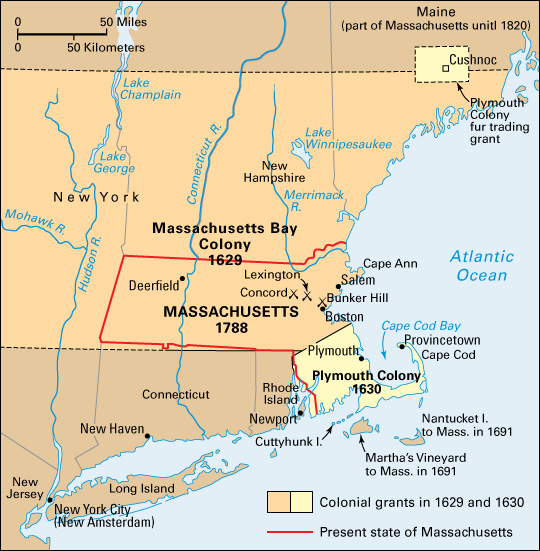
Progress as a state.
Massachusetts prospered during its early years as a state. In the early 1800’s, France and the United Kingdom were at war. American shipowners who were willing to send their vessels into European waters could make huge profits. But both the British and the French tried to attack ships bound for their enemy’s ports. President Thomas Jefferson feared that such an attack on an American ship might force the United States into the war. In 1807, he persuaded Congress to pass the Embargo Act, which stopped American exports to other countries and prohibited U.S. ships from sailing into foreign ports.
Hardships resulting from the embargo and the War of 1812 forced a new way of life upon the people of Massachusetts. Goods had to be manufactured at home rather than imported. In 1814, Francis Cabot Lowell built a textile factory in Waltham. It was one of the first factories in the United States. A number of other textile mills were soon operating in eastern Massachusetts. With the opening of New York’s Erie Canal in 1825, crops could be brought to New England from the west. Farming in Massachusetts suffered. Many farmers left the state or went to work in factories.
In the 1840’s, large numbers of Irish immigrants came to the state. They provided cheap labor for the factories. The competition for jobs caused tensions between the immigrants and many native U.S. citizens of the state.
The whaling industry flourished in New Bedford, Nantucket, and Boston until the early 1860’s. It declined after kerosene replaced whale oil.
The abolitionist (antislavery) movement received wide support in Massachusetts. In 1831, William Lloyd Garrison of Boston began publishing his antislavery newspaper The Liberator. In 1832, abolitionists formed the New England Anti-Slavery Society in Boston. The society helped enslaved people escape to Canada. Some people in Massachusetts opposed the abolitionists. They objected to what they considered extremist tactics. They also feared that the Southern planters might cut off the cotton supply for the Massachusetts textile industry.
In 1850, Congress passed a series of acts which it hoped would settle the conflict between slaveholders and those who opposed slavery. These acts were called the Compromise of 1850 (see Compromise of 1850). Senator Daniel Webster of Massachusetts defended the compromise as necessary to preserve the Union. But many persons in Massachusetts disagreed. Abraham Lincoln and the Republican Party carried the state in the 1860 presidential election.
Massachusetts gave strong support to the Union during the American Civil War (1861-1865). The state furnished more than 125,000 men to the Union Army and about 20,000 men to the Navy. Massachusetts shipbuilders built and equipped many Union ships.
Industry in the state expanded after the war. The textile industry prospered, and the leather and metal products industries also grew rapidly. Thousands of immigrants poured into the state to meet the great demand for industrial labor.
In the mid-1870’s, the American inventor Alexander Graham Bell developed the telephone in Boston. A telephone line between Boston and Providence, Rhode Island, was installed in 1881.
The early 1900’s.
The population swelled to about 21/2 million by 1900. About 30 percent of these people came to the United States from other countries. This huge number of people, with their variety of backgrounds, brought new problems to the state. Communities had to provide such services as water supply, sewerage, housing, and police protection. Industrial workers became unhappy with wages and working conditions. A textile strike in Lawrence in 1912 brought nationwide attention to poor working conditions in the textile industry. Improvements followed the strike.
The United States entered World War I in 1917. The Yankee (26th) Division of Massachusetts was the first National Guard division to reach the battlefields of France. Prices climbed in Massachusetts during the war, and workers demanded higher wages to meet the increased cost of living. But often such demands were not met. In 1919, the mayor of Boston refused to let the city’s police form a union. About three-fourths of the Boston police force went on strike. Governor Calvin Coolidge helped end the strike by sending the National Guard into Boston. Coolidge gained nationwide fame because of his action and was elected vice president of the United States in 1920. Three years later, Coolidge became president following the death of President Warren G. Harding. After filling out Harding’s term, Coolidge was elected in 1924 to a full term as president.
Massachusetts’s economy suffered during the 1920’s because of competition from the textile and shoe industries in Southern and Western states. But other industries continued to prosper. In 1929, the Great Depression hit the United States. Massachusetts carried on its own unemployment-relief program until the federal government organized nationwide programs.
The mid-1900’s.
The state’s economy soared during World War II (1939-1945). Massachusetts factories and shipyards produced huge quantities of war materials and supplies.
Many traditional Massachusetts industries, including the manufacture of shoes and textiles, declined greatly during the 1950’s and 1960’s. Many industries in the state began to switch to space and rocket research or the production of electronics equipment. Hundreds of research laboratories developed in and around Boston, using the facilities and personnel of the many colleges and universities in the area. The United States Navy launched its first nuclear surface ship, the cruiser Long Beach, at Quincy in 1959.
Like many other states, Massachusetts faced serious racial problems during the mid-1900’s. In 1957, the state legislature prohibited segregation in public housing. New legislation in 1963 made segregation illegal in most private dwellings as well. During the mid-1970’s, Boston’s public schools were desegregated by order of a federal court.
During the 1950’s and 1960’s, the Kennedy family of Brookline became powerful in state and national politics. John F. Kennedy served as president of the United States from 1961 until his assassination in 1963. When elected president, he was representing Massachusetts in the U.S. Senate. His brother, Robert F. Kennedy, served as U.S. attorney general from 1961 to 1964. Robert Kennedy was elected to the U.S. Senate from New York in 1964. He was assassinated in 1968 while campaigning for the Democratic presidential nomination. The youngest Kennedy brother, Edward M. (Ted) Kennedy, served as a U.S. senator from Massachusetts from 1962 until his death in 2009.
The late 1900’s.
In Massachusetts, as in other states, large numbers of people and industries moved from the cities to suburbs in the last half of the 1900’s. Massachusetts remained a center for military research and development and a leader in banking, education, insurance, and medical care. A nationwide recession in the early 1990’s hit Massachusetts and other northeastern states especially hard. But growth in such industries as high-technology and tourism helped the state recover.
The early 2000’s.
Massachusetts officials continued working in the early 2000’s to ease several problems common to many states. These problems included air and water pollution, a housing shortage in cities, and racial tension.
In Boston in 2003, an underground highway replacing the city’s Central Artery opened for traffic. The work to replace the overcrowded Central Artery had begun in 1991. The Central Artery, built in the 1950’s, was the first elevated highway constructed in the center of an American city. By the late 1900’s, it was not able to handle the increased traffic. The Central Artery/Tunnel project, also called the Big Dig, was one of the country’s most expensive, most complex, and most technologically challenging highway projects.
Massachusetts became a focus of controversy in November 2003 over same-sex marriages. That month, the state’s Supreme Judicial Court ruled that not allowing same-sex couples to marry was a violation of the state’s Constitution. The court set May 17, 2004, as the deadline for the state to begin offering marriage licenses to couples of the same sex. The governor and the legislature sought to delay the ruling, but the court held to its deadline. Same-sex marriages became legal in Massachusetts on May 17, 2004.
In April 2006, Massachusetts became the first U.S. state to require that its residents obtain health care coverage. Governor Mitt Romney signed legislation that required people without health insurance to buy it by July 1, 2007. The law calls for the state government to subsidize coverage for low-income residents.
In November 2006, Democrat Deval L. Patrick became the first African American elected governor of Massachusetts. Patrick was the nation’s second African American governor since the Reconstruction period (1865-1877). L. Douglas Wilder, Virginia’s governor in the early 1990’s, was the first.
Massachusetts became the center of the world’s attention on April 15, 2013, when terrorists exploded two bombs near the finish line of the Boston Marathon. Three people were killed and more than 200 were injured in the explosions. After the bombing, the terrorist suspects, brothers Tamerlan and Dzhokhar Tsarnaev, killed a law enforcement officer and wounded several others. On April 19, Tamerlan Tsarnaev was killed, and his brother was captured.
In 2015, a federal jury found Dzhokhar Tsarnaev guilty of the bombing and other crimes. The jury sentenced him to death. Tsarnaev’s lawyers appealed the court’s decision. In 2016, a federal judge denied the appeal. In 2020, a federal appeals court overturned Tsarnaev’s death sentence and ordered a new penalty phase to the trial, allowing a new jury to determine whether Tsarnaev should be executed. In 2022, however, the Supreme Court of the United States reinstated Tsarnaev’s death sentence.
Beginning in 2020, Massachusetts faced a public health crisis due to the COVID-19 pandemic. Cases of the sometimes-fatal respiratory disease rose sharply in March. The state closed schools and limited the size of gatherings in order to contain the spread of the disease. Authorities later issued a series of stay-at-home advisories and ordered the closure of businesses considered nonessential. Infection rates declined in the late spring and summer months, and businesses and public areas reopened with firm social distancing guidelines in place. Cases and hospitalizations rose sharply late in the year, prompting tighter restrictions on business and social activity.
COVID-19 vaccines became available to most Massachusetts adults in late 2020 and early 2021. By mid-2021, an increase in vaccination rates contributed to a decrease in the state’s infection and death rates. Outbreaks continued to occur, however. In March 2022, a decline in infection rates led authorities to end remaining restrictions, such as face-mask requirements in public schools. By early 2023, more than 2 million COVID-19 infections had been recorded in Massachusetts, and about 25,000 people there had died from the disease.
